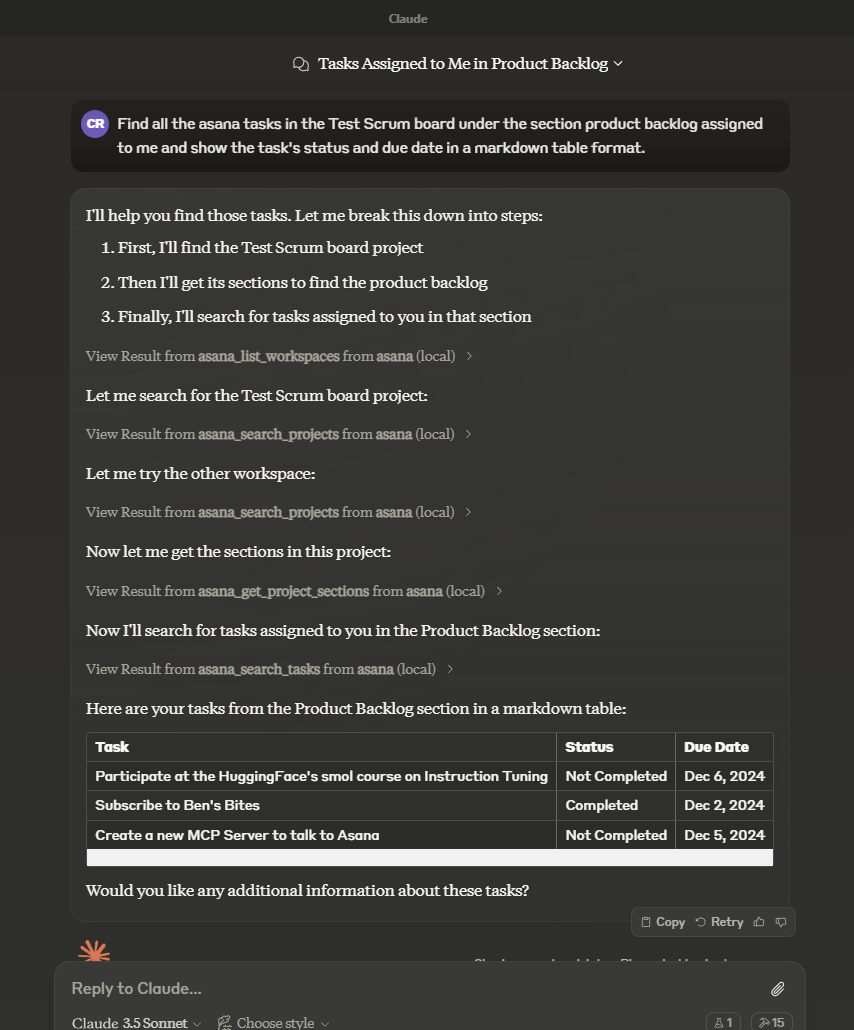About
Enables AI tools like Claude to query and manipulate Asana data through MCP, providing read/write operations for tasks, projects, workspaces, with optional read-only mode for safe testing.
Capabilities

The Roychri MCP Server for Asana bridges the gap between AI assistants and the Asana task‑management ecosystem by exposing a rich set of tools through the Model Context Protocol. Developers and teams that rely on AI‑powered workflows can now query, manipulate, and monitor Asana data without leaving their preferred conversational interface. Whether you are building a chatbot for project oversight, an automated reporting assistant, or a voice‑controlled task manager, this server translates natural language intent into precise Asana API calls and returns structured results that the LLM can seamlessly incorporate into its responses.
At its core, the server implements a collection of tools that mirror common Asana operations: listing workspaces, searching projects and tasks with advanced filtering, retrieving task details or stories, creating new tasks, and updating existing ones. Each tool accepts a clear set of inputs—often optional—to give the assistant fine‑grained control over what data to fetch or modify. For example, lets you filter by assignee, tags, completion status, and even sort the results by due date or creation time. This level of granularity empowers developers to craft highly specific queries that match real‑world reporting needs, such as “Show me all blocked tasks assigned to the front‑end team in Sprint 30.”
The server’s value lies not only in its feature set but also in how it integrates with AI workflows. By simply mentioning the keyword “asana” in a conversation, Claude or any MCP‑compatible client can automatically surface relevant tools. The assistant then prompts the user for missing parameters, invokes the appropriate tool, and injects the returned data into its reply. This pattern eliminates context switching between a separate Asana UI and an AI chat, streamlining task management directly from the conversation. For teams that already use Asana as their central hub, this tight integration reduces friction and speeds up decision‑making.
Real‑world use cases span from agile sprint reviews—where an assistant can list unfinished tasks, highlight overdue items, and even create follow‑up tasks—to compliance audits that pull all archived projects within a workspace. Customer support teams can use the server to fetch recent task comments, giving agents instant insight into project discussions. Even simple “check‑in” bots can remind users of pending tasks or upcoming deadlines by querying Asana in the background.
What sets this MCP server apart is its declarative, tool‑centric design combined with a comprehensive set of filtering options. Developers benefit from the ability to expose only the tools they need, keeping the interface clean and focused. The server’s adherence to MCP standards ensures compatibility with a growing ecosystem of AI assistants, making it a future‑proof addition to any AI‑enabled productivity stack.
Related Servers
Netdata
Real‑time infrastructure monitoring for every metric, every second.
Awesome MCP Servers
Curated list of production-ready Model Context Protocol servers
JumpServer
Browser‑based, open‑source privileged access management
OpenTofu
Infrastructure as Code for secure, efficient cloud management
FastAPI-MCP
Expose FastAPI endpoints as MCP tools with built‑in auth
Pipedream MCP Server
Event‑driven integration platform for developers
Weekly Views
Server Health
Information
Explore More Servers
Aligo SMS MCP Server
Send and query SMS via Aligo API with MCP compatibility
Monorail MCP Server
AI‑powered crypto quotes and token data from 11 exchanges
Laravel MCP
Standardized AI‑Assistant API for Laravel
macOS Screen View & Control MCP Server
Capture macOS window screenshots and control windows via LLMs
Beanquery MCP Server
Query Beancount ledgers with AI via Model Context Protocol
AIND Metadata MCP Server
Access Allen Institute neural data with a single protocol